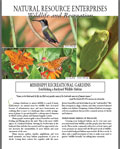Game Animals
Non-game Animals
Habitat
Backyard Forests
- Provide wildlife habitat
- Remove carbon dioxide in the air
- Prevent soil erosion
- Migrate stormwater runoff
- Can provide timber and wood products
Habitat Description: Backyard Forests
In many parts of the country, forested land is being converted to urban spaces and agricultural land at a rate of one hundred acres a day. As large forests are lost, backyard forests have become even more important. Backyard forests can provide wildlife habitat, remove carbon dioxide in the air, prevent soil erosion, reduce energy costs and mitigate stormwater runoff. Backyard forests are often established because they provide cost savings, alternative wood sources and aesthetic qualities to a landscape.
Healthy backyard forests are functioning ecosystems with a diversity of young and mature trees. Fruit or nut-bearing trees and berry-producing shrubs add diversity, color and sustain wildlife. Well-managed backyard forests can support a wide range of birds and mammals.
Some of the biggest threats to small forests are insects and pathogens that can cause tree mortality. Pathogens occur naturally in ecosystems but practices such as planting only a single species, delaying harvest beyond tree maturity and harvesting only the largest trees can cause even more frequent and severe outbreaks. Creating a management plan will target potential problems and planting a good diversity of trees can help ensure a healthier habitat.

Mississippi Recreational Gardens: Establishing a Backyard Wildlife Habitat (PDF)
Mississippi State University Extension Service, Natural Resource Enterprises Program
All wildlife requires food, water and shelter to survive. This publication discusses providing those necessities in a backyard environment. Detailed information is given on how to attract birds, hummingbirds, butterflies, bats, snakes, lizards, toads and frogs. Information is also provided on controlling deer, rodents, and other animals that are considered pests. Management tips are given for making your backyard the best habitat possible including an example and how to create a trail.
Make a Master Plan (PDF)
Indiana Woodlot Owner Series
Backyard woods need to be tended to get the best results. Determine what your goals are and create an inventory of what you have on your property. From these you can develop a plan to reach your goals.
Keep Your Woods Healthy (PDF)
Indiana Woodlot Owner Series
Backyard woods are subject to forest insects and pathogens, just like any other woods. You can keep your backyard forest healthy by increasing species diversity, increasing stand vigor, and increasing age diversity. If a tree health problem arises, you need to be able to identify it and the follow prescribed treatments. This publication discusses maintaining a healthy woodlot and identifying and treating forest health problems.
Help Your Preferred Trees Grow (PDF)
Indiana Woodlot Owner Series
You can assist selected trees to get a competitive advantage by eliminating other trees and opening the forest canopy. This will allow the select trees to grow larger and be of higher quality. You may want to favor individual trees for different objectives. This publication discusses how to select preferred trees and how to manage your backyard woodlot for them.
Grow and Collect Special Forest Products (PDF)
Indiana Woodlot Owner Series
Berries, mushrooms, nuts, wild fruits, decorative floral materials, and maple syrup are types of special products that can be collected from backyard woodlots. This publication discusses each product and how to produce and collect them.
Protect Clean Water (PDF)
Indiana Woodlot Owner Series
Your backyard woodlot acts as a living filter, cleaning water of toxic substances, nutrients, and other materials. This publication discusses how your woodlot acts as a water filter and how to reduce the impact of your management activities on this important activity.
Prune Your Trees (PDF)
Indiana Woodlot Owner Series
Pruning can be done for safety, to improve tree health, for aesthetics, and to improve the value of wood products. This publication discusses selecting trees to prune, what time of year to prune, and how to prune trees.
Deer Management Assistance Program (DMAP)
Indiana Woodlot Owner Series
Your backyard woodlot can produce wood products for additional income. Firewood, fence posts, sawlogs, and other wood products can be harvested. This publication discusses the options and how to properly grow and harvest these products.

